Intro
Fork offset has received a lot of attention in the last few years, and manufacturers have recently started offering certain forks in multiple offset options, along with bike frame manufacturers touting geometry tailored for the new crop of shorter-offset forks. But what is fork offset in the first place, and why should we care about it? Or should we, at all?
In this Gear 101 article, I’ll dive into those things, go over some examples, and hopefully provide a better idea of how fork offset actually plays a role in how different bikes feel on the trail.
And if you haven’t already, this would be a great time to check out our Bike Fit & Geometry 101 article for a good glossary of a lot of the terms we’ll be using in this one.
Background
To start off, what is fork offset? Simply put, it’s the distance between the fork’s steering axis (i.e., the centerline of the steerer tube) and the center of the dropouts, measured perpendicular to the steering axis.
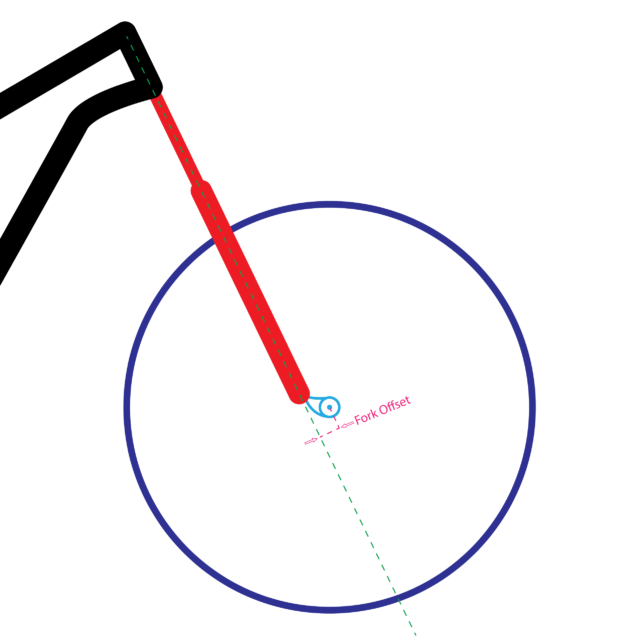
Since it’s measured perpendicular to the steering axis, offset is a property of a fork, independent of the bike it’s mounted to. Every fork on the market has some amount of positive offset, generally in the range of 36-58 mm or so, with variations depending on the intended use and wheel size, which we’ll get into below.
Many modern forks have multiple options for offset between otherwise identical forks. In a lot of cases, it’s also possible to make “frankenforks” with offsets that the manufacturer doesn’t offer by doing things like swapping crown / steerer tube / stanchion assemblies (commonly abbreviated to “CSU”) between forks meant for different wheel sizes.
[Of course, there are a lot of ways to do these kinds of swaps wrong, and thus try to assemble a fork from parts that simply don’t work together. A comprehensive guide to successfully doing these sorts of swaps would be a massive tome unto itself, so we wouldn’t recommend it unless you’re familiar with what’s necessary to make it work right.]
In general, forks meant for larger wheels tend to have more offset, while those meant for smaller wheels have less. For example, the standard offsets for the Fox 36 fork are 37 mm for 26” wheels, 44 mm for 27.5” wheels, and 51 mm for 29ers. Fox has now added 37 mm offset options for 27.5” forks and 44 mm ones for 29ers. RockShox’s offerings don’t use identical numbers, but they’re very similar.
Fork Offset & Trail Measurements
So, why vary offset with wheel size? The thinking here stems from the measurement of “trail” and its related property, “mechanical trail.” Trail is the horizontal distance from the contact point of the front tire on the ground to the point where the steering axis intersects the ground. This formulation gets a little more complicated than offset – now the fork offset, the headtube angle of the bike, and the radius of the wheel / tire combination being used play a role.
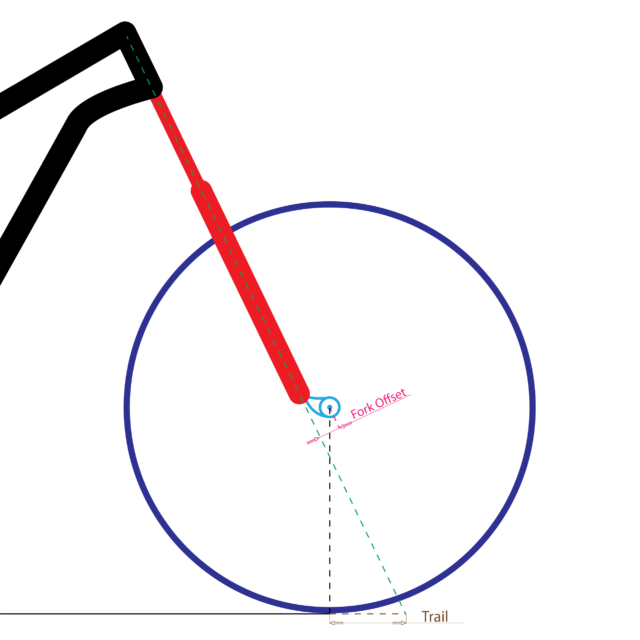
Mechanical trail is nearly the same, except that it’s measured perpendicular to the steering axis of the bike, rather than horizontally along the ground. The two measurements are closely related and changes to a bike’s geometry that would increase one would also increase the other, and vice versa.
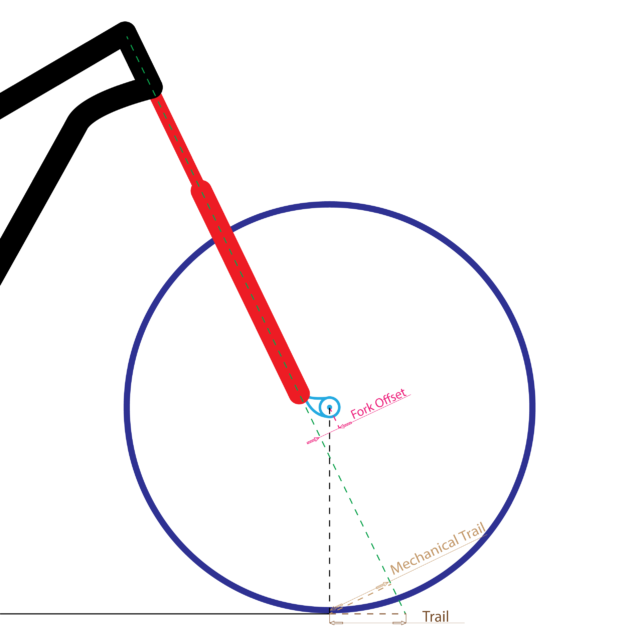
Trail is referenced a bit more often, likely because it’s a little easier to visualize, but I’d argue that mechanical trail is more useful since it directly represents the length of the lever arm from the tire contact point and the steering axis. Using mechanical trail also makes some of the math I’m going to outline slightly simpler, so I’ll be using mechanical trail for the remainder of this article. But again, the two are very closely related, and everything that I say about general trends applies to both.
The mathematical formulation of mechanical trail is as follows:
Tm = R * cos(θh) – Of
Where Tm is the mechanical trail, R is the radius of the tire, θh is the headtube angle, and Of is the fork offset.
[If you’ve just read that an are having a panic attack because you’ve completely forgotten what trigonometry is, don’t worry. I’ll explain it all graphically, too.]
So with that equation in mind, a 29er with the same headtube angle and fork offset as a 26” wheeled bike is going to have considerably more mechanical trail. If a graphical explanation works better for you than the math, just think about this as being because the larger wheel radius means that the imaginary line of the steering axis extends further forward before it reaches the ground.
This explains the general trend of brands using larger offsets on forks designed for larger wheels – the greater offset counteracts the increase in trail value that comes with the increased wheel radius. If we suppose that maintaining similar trail numbers across wheel sizes makes sense, this is the way to make it happen (but as I’ll get into below, I don’t think that approach always makes sense).
Similarly, an otherwise identical bike with a slacker head angle will also have more mechanical trail.
And finally, a shorter-offset fork on an otherwise identical bike will produce more mechanical trail.
Great, so we just got to have flashbacks to our high school trigonometry class, but why does it matter?
In short, mechanical trail has a significant impact on the steering feel of a bike. As I noted earlier, the mechanical trail is the length of the lever arm from the steering axis to the contact point of the tire. On a “normal” bike – anything save for perhaps some very strange oddities – the steering axis passes well forward of the tire contact point. The result of this is that, in order to turn the handlebars, the contact point of the tire has to sweep in an arc behind the steering axis – at least, if the bike and rider remain perfectly upright.
More realistically, given the complex, dynamic nature of a rider moving around on a bike, the act of turning the bars helps initiate lean into the turn. Turning the bars forces either the tire contact patch to scrub / slide sideways, or the bike to lean over into the turn, or some combination thereof. The more mechanical trail, the greater the degree of movement. That is to say, either the bike needs to lean into the turn – which isn’t desirable at low speeds – or the contact patch needs to scrub sideways, which takes additional effort.
The result of this is that the steering on a bike with a higher mechanical trail number is generally more stable near dead center, with the front wheel pointing forward. Starting to turn the bar requires more overall movement of the center of mass of the bike and rider than it does on a bike with less mechanical trail.
The other consequence of this sweeping motion is wheel flop. If you turn your handlebars with the frame of the bike held straight, the front end of the bike drops slightly. This wheel flop factor – the distance that the center of the axle drops when the bars are turned from straight ahead to 90 degrees sideways – can be described by this equation:
f = Tm * cos(θh)
Where f is the wheel flop, Tm is the mechanical trail, and θh is the bike’s headtube angle. Since the flop is directly related to the mechanical trail, the same factors that increase mechanical trail also increase flop – though headtube angle has an outsized effect compared to fork offset and wheel radius.
Wheel flop doesn’t make much difference when the steering inputs are small – i.e. when the bars are turned very little – but becomes more noticeable the further they’re turned. Bikes with more mechanical trail, especially ones where that mechanical trail value is high particularly due to a slack headtube angle, experience more wheel flop. The main impact of wheel flop is that it makes the steering harder to manage at low speeds when turning the bars a great deal; once the bars are turned substantially, starting the flop, they want to keep going, and straightening out of the turn requires raising the front end back up, out of the flop, which takes more work.
Fork offset also has an impact on how well a bike holds a line when running into obstacles. Imagine running into a square-edged rock with the front tire. If you hit the rock straight on, the load is distributed across the whole width of the tire, and the bars don’t kick to the side. But if you catch the corner of the rock with the right side of the tire, the handlebars want to kick right, and you’ll have to fight off that input to hold a straight line.
As we’ve talked about, the mechanical trail is the length of the lever arm between the tire contact point and the bike’s steering axis, but it’s critical to note that this is only true when the contact point is at the bottom of the tire, i.e. you’re riding on a flat surface, like a paved road. In the scenario mentioned above, the rock actually impacts the tire well above its lowest point. In this scenario, the length of the lever arm changes significantly – let’s call this the “effective mechanical trail” – a term I’ve just made up – which now factors in variations in tire contact point.
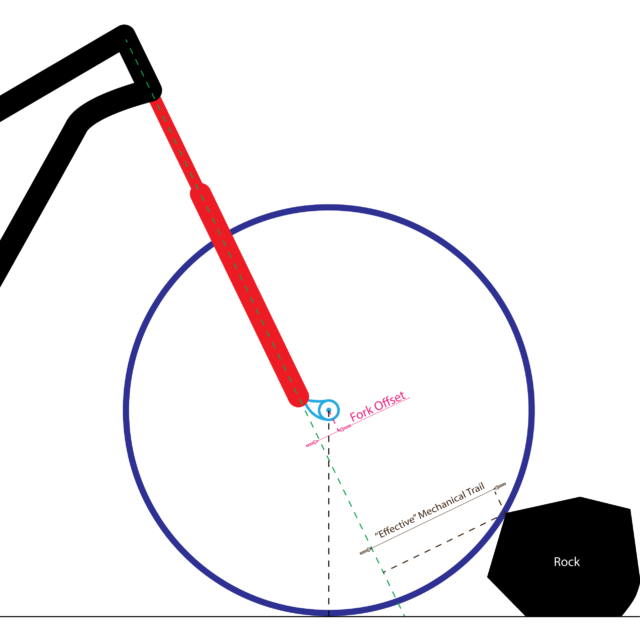
The math here gets a lot more complicated, so I’ll spare you wading through that. But the upshot is that, when the contact point with an obstacle is moved just a little bit above ground level, it soon moves forward of the steering axis, rather than behind it, as you can see above. The height at which this crossover happens – i.e., where the “effective mechanical trail” momentarily goes to zero – depends on wheel size, fork offset, and headtube angle, but it’s in the range of ~10 to 25 mm for “normal” bikes. As the height of the obstacle increases from there, the magnitude of the effective mechanical trail increases again, and the obstacle has greater leverage over the steering of the bike.
The result of this is that going to a shorter-offset fork actually means that the wheel has less leverage over / doesn’t affect the steering as much when running into bigger obstacles that sit higher above ground level – precisely when the impact force from hitting the obstacle is also bigger (the bigger the rock, the bigger the impact). Therefore, shorter-offset forks make the steering more stable when it comes to resisting larger impacts applied to the wheel that would be prone to kicking the bar to the side.
How this plays out on the, uh, trail
How does this all shake out in terms of on-trail feel? Put as simply as possible – and this is a broad generalization – longer mechanical trail values favor high-speed handling, where cornering is driven more by bike lean than actually turning the handlebars. Conversely, shorter mechanical trail values feel more natural at lower speeds, where a greater degree of steering angle is required, and you don’t want to drastically lean over your bike.
This all makes sense, given what we’ve talked about above. Lots of mechanical trail helps a bike initiate lean into a corner, but becomes floppy and harder to control when the bars are turned a great deal (e.g., a tight switchback). High-speed cornering happens through leaning much more than it does through turning the handlebars. Conversely, at very low speeds where turning requires dramatically turning the bars, the tendency of a bike with lots of mechanical trail to lean and flop into the turn is undesirable from a balance perspective; at low speeds, a rider doesn’t want to lean into a turn.
Fork offset also impacts stability when trying not to turn. As I mentioned before when I was introducing the idea of “effective mechanical trail,” when you’re running into taller, off-camber obstacles, a shorter-offset fork is noticeably less prone to getting knocked off line. Similarly, a shorter-offset fork makes the steering feel a bit slower (i.e., you need to put in more effort to turn the bars), and thus calmer at high speeds, but more sluggish when making tighter, lower-speed turns.
I’ve directly a/b tested forks with different offsets on a variety of bikes now, including my personal BTR Ranger and Nicolai G16, and a Guerrilla Gravity Smash. It’s worth noting that it’s basically impossible to only change fork offset in isolation; even just swapping the CSU to alter the offset on the same fork also slightly changes the front center length, and thus the wheelbase of a bike. Going forward, when referring to changing offset, I’m talking about changing to a fork with a different offset, and all that entails.
The differences I’ve described above are borne out in actual on-trail feel in my experience; a shorter-offset fork feels a bit more stable at speed and when hitting obstacles with the front wheel, especially off-camber obstacles. It also helps a bike arc into a medium- to high-speed corner more smoothly and naturally. Conversely, a longer-offset fork feels a bit more twitchy at speed, is more prone to getting deflected off-line, but is also easier to handle at more moderate speeds, largely due to the reduced wheel flop sensation we’ve already discussed. With the shorter-offset forks, steering with substantial bar movement (e.g., really tight corners) requires more rider weight shift to maintain balance, and therefore is slightly more work and a little trickier.
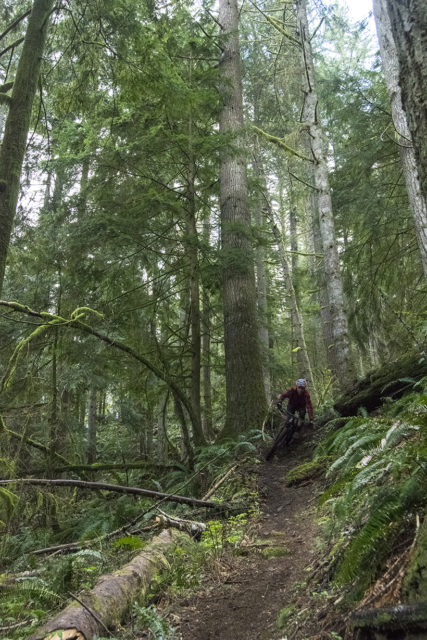
To be clear, none of these changes are wildly dramatic when operating within the normal bounds of different fork offsets that are readily available, but they are real. In my testing, I was using 37 to 45 mm offset forks with 27.5” wheels, 44 to 51 mm offset forks with 29ers, and on bikes with headtube angles in the 65° to 62° range.
I also noticed that the changes in feel are more pronounced at more extreme headtube angles. For example, when riding the Smash (~64.5° headtube angle with a 160 mm fork) with 29” wheels front and back, I don’t have a terribly strong preference for longer or shorter fork offset. As Noah Bodman and I wrote in our review, the Smash is a very versatile bike that’s very capable, but isn’t a fully committed descending machine either; it’s pretty nimble and sprightly, too.
But I’ve also set up that bike as a mullet with a 29” wheel up front and a 27.5” out back, and the smaller rear wheel of course slackens the head angle and drops the bottom bracket significantly, making the bike feel more aggressive and descending oriented. In that configuration, the shorter 44mm-offset fork feels like a more obvious choice. The tendency of the shorter-offset fork towards more stability is more in keeping with the overall feel of the mullet-version of the Smash.
The same is true for the G16 in particular, a bike with a very slack head angle and a long wheelbase. Getting the fork offset down to 37 mm on the G16 – which I’ve done through a combination of stuffing a 27.5” wheel into a 26” fork and using the Mojo MORC 40 offset-reducing crowns (review coming soon) – makes for a clear improvement over a longer-offset fork, given the G16’s very clear preference for riding hard and fast downhill.
The Limitations of Trail
The problem with trail or mechanical trail, when it comes to describing a bike’s handling, is that it’s only one variable amongst many that matter. That’s not to say that all 2400+ words you just read on the matter are worthless; rather, trail is one characteristic that plays a role in a bike’s handling, which has some utility when comparing fairly similar setups, but becomes meaningless when the differences in other attributes are substantial.
Let’s put that into perspective. A bike with 27.5” wheels, a 62° headtube angle, and a 52mm-offset fork – totally realistic numbers for a downhill bike with a Fox 40 fork – has almost exactly the same mechanical trail value as a 29er with a 65° headtube angle and a 44mm-offset fork, or a 27.5” bike with a 65° headtube angle and a 36mm-offset fork. Despite those setups having similar mechanical trail numbers, those bikes are still going to feel hugely different due to all of the other factors.
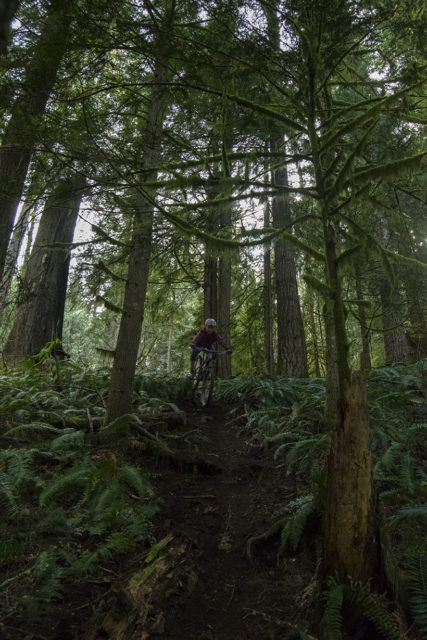
And now for a rant: I’d argue that fork manufacturers have fallen into this exact trap. For a long time, dual-crown downhill forks have had dramatically longer offsets than the burliest single crowns in the same manufacturer’s lines. To stick with Fox, as an example, the prior generation Fox 40 fork had 45 mm of offset for 26” wheels, 52 mm for the 27.5” version, and a monstrous 58 mm for the 49 (which is what they called the 29” version prior to the 2021 model year). The 2021 Fox 40 fork reduced these a bit, to 48 mm for the 27.5” fork and 52 mm for the 29er version (the 26” fork is no more, may it rest in peace). RockShox now offers reduced-offset versions of their Boxxer DH fork, at 36 mm for the 27.5” fork and 46 mm for the 29er, but until recently those were limited to 46 mm and 56 mm, respectively.
That’s absurd! The overwhelming majority of dual-crown downhill forks are being used for exclusively lift- and shuttle-access riding where handling at slow climbing speeds is utterly irrelevant. It seems that the manufacturers’ goal was to maintain a similar steering feel between aggressive Enduro / Trail bikes and legit downhill bikes. In my opinion, that’s the wrong goal. For one, the use cases are dramatically different when you completely remove climbing and riding on rolling, varied terrain from the equation. A downhill bike needn’t make any concessions to anything other than descending at speed, and can and should be a purpose-built tool to that end. Trying to make a DH bike steer exactly like a Trail bike doesn’t make sense, and furthermore, other aspects of the bike’s geometry, suspension, weight distribution, etc. differ so wildly between Trail & Downhill bikes that such a goal isn’t obtainable anyway.
More broadly speaking, I think the right way to look at fork offset is not as a way to correct the handling behavior of a bike that doesn’t fit its desired use case, but rather as a complementary piece of bike geometry. Varying fork offset to maintain a fairly consistent trail number on bikes with similar intended uses and otherwise similar geometry — but differing wheel sizes — makes sense. Using offset try to quicken up a fundamentally stable bike, or mellow out a very quick-handling one is looking at it backward. Just as one wouldn’t make a reverse sidecut ski and then give it a ton of camber underfoot in an effort to give it some edge hold, it doesn’t work to combine wildly competing aspects of bike geometry in an effort to achieve some sort of “best of both worlds.”
Bottom Line
If you’re putting together a bike that’s meant to almost exclusively descend at speed really well, go all-in on that. A slack headtube angle, longer chainstays to balance out the increased front center from that headtube angle, and a short-offset fork to complement the increased stability are all sensible decisions. The more versatile you want the bike to be over a variety of terrain and speeds, the more it makes sense to moderate all of those variables.
Fork offset isn’t a silver bullet that’ll wildly change the overall character of a bike; if you’re looking for it to dramatically alter the way a bike handles, chances are you’re just starting with the wrong bike. That said, a shorter-offset fork can make a positive change in making a fairly stable bike a touch more so, just as a longer-offset fork can help speed up the handling of an already quick one. For most people, it’s probably not worth going out and buying a new fork solely to tweak offset, but it’s worth keeping in mind as an option when buying a new fork, or experimenting with if you have multiple forks on hand.

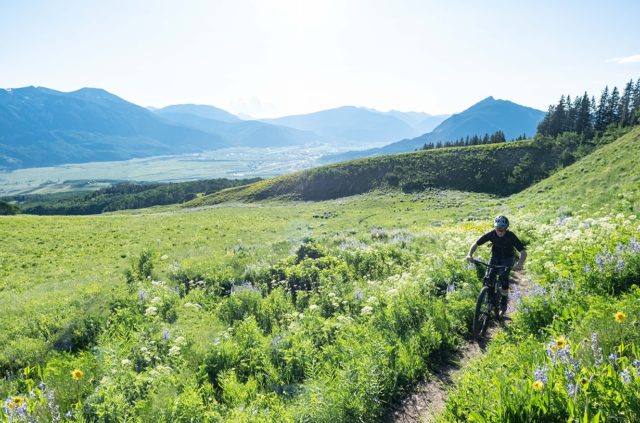
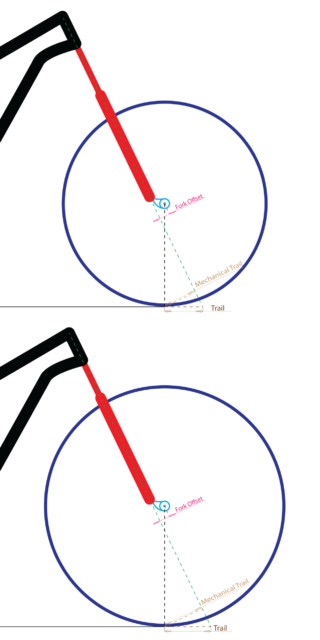
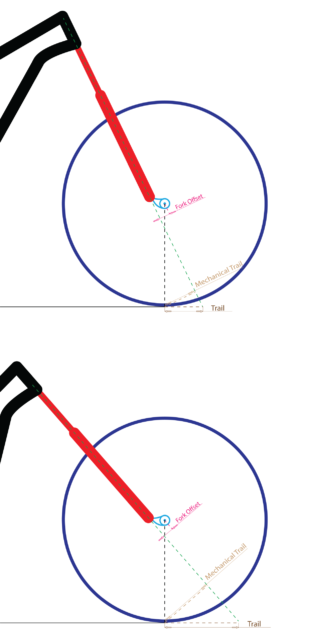
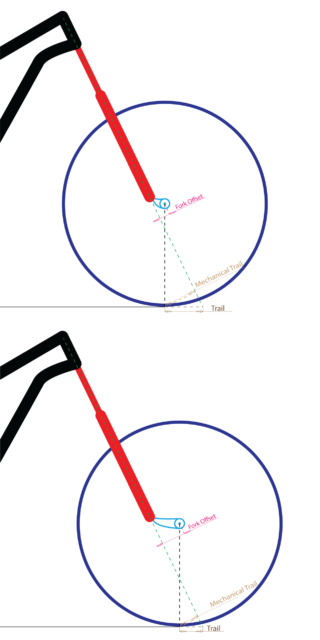
Thanks for this – building up a SB100 right now and was wondering the reasoning behind the 44mm offset as opposed to 51mm on my SB4.5. Pretty cool stuff.
Well written article. I had assumed **incorrectly** that a bigger offset would slacken out the geometry and make the bikes handling more stable and less twitchy. I was going to order a 120mm fork for my old hard trail, but after reading this, I’m convinced I just need a NEW bike….AND I can use trigonometry in the pitch to my wife. She can’t argue with math right? RIGHT??
I think we’d all do well to pay a bit of extra heed to math and science right now. If science says you need a new bike, so be it.
I switched from a bike with a 67* HA, and 51mm offset, to a bike with 67* HA and 37mm offset. I run a 27.5×2.8 plus wheel, and the first bike was a standard 29er fork, the second was a short offset 27.5 fork.
I did that, because with a 520mm reach, I wanted to keep the front center from becoming to long, in order to keep enough weight on the front wheel.
As you say, it is impossible to isolate one aspect completely since every change in one also changes another aspect.
In my case I found no decrease in slow speed handling, if anything it felt better, despite the increase in wheel flop. It WAS a very different feeling.
David,
Excellent explanation of fork geometry, thank you!
I’m a little late to the party,…
I’m about to go from a 29+ 69HA 51 offset, to a 27.5 fat bike.
I find the plus bike just a little bit too sensitive steering at slow speeds on winter trails.
I’m wondering if the 27.5×4.5 fat bike with 67.5 HA would benefit from a 45-47 offset
or, if it would already be quite calm, due to HA and larger tires?
Thanks.
Mike.
Thank you for this. Great reading. Perfect article. I had started reading it several times in the past but never completed it. This time I made it and it was totally worth to do it. I plan to swap my 56 mm rake Fox 40 29” crowns for 44 mm option and your article may play significant role in my decision process.